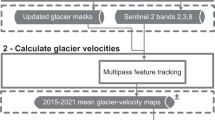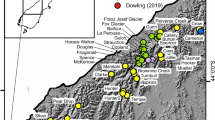Abstract
Knowledge of the ice thickness distribution of the world’s glaciers is a fundamental prerequisite for a range of studies. Projections of future glacier change, estimates of the available freshwater resources or assessments of potential sea-level rise all need glacier ice thickness to be accurately constrained. Previous estimates of global glacier volumes are mostly based on scaling relations between glacier area and volume, and only one study provides global-scale information on the ice thickness distribution of individual glaciers. Here we use an ensemble of up to five models to provide a consensus estimate for the ice thickness distribution of all the about 215,000 glaciers outside the Greenland and Antarctic ice sheets. The models use principles of ice flow dynamics to invert for ice thickness from surface characteristics. We find a total volume of 158 ± 41 × 103 km3, which is equivalent to 0.32 ± 0.08 m of sea-level change when the fraction of ice located below present-day sea level (roughly 15%) is subtracted. Our results indicate that High Mountain Asia hosts about 27% less glacier ice than previously suggested, and imply that the timing by which the region is expected to lose half of its present-day glacier area has to be moved forward by about one decade.
This is a preview of subscription content, access via your institution
Access options
Access Nature and 54 other Nature Portfolio journals
Get Nature+, our best-value online-access subscription
$29.99 / 30 days
cancel any time
Subscribe to this journal
Receive 12 print issues and online access
$259.00 per year
only $21.58 per issue
Buy this article
- Purchase on Springer Link
- Instant access to full article PDF
Prices may be subject to local taxes which are calculated during checkout



Similar content being viewed by others
Code availability
The codes used to generate individual results are available through the contact information from the original publications. Requests for further materials should be directed to D.F.
Data availability
The ice thickness distribution of all about 215,000 glaciers, as estimated with the individual models and the composite solution, is available at https://doi.org/10.3929/ethz-b-000315707.
References
Vaughan, D. et al. in Climate Change 2013: The Physical Science Basis (eds Stocker, T. F. et al.) 317–382 (IPCC, Cambridge Univ. Press, 2013).
Lambeck, K., Rouby, H., Purcell, A., Sun, Y. & Sambridge, M. Sea level and global ice volumes from the Last Glacial Maximum to the Holocene. Proc. Natl Acad. Sci. USA 111, 15296–15303 (2014).
Kaser, G., Großhauser, M. & Marzeion, B. Contribution potential of glaciers to water availability in different climate regimes. Proc. Natl Acad. Sci. USA 107, 20223–20227 (2010).
Rodell, M. et al. Emerging trends in global freshwater availability. Nature 557, 651–659 (2018).
Marzeion, B., Jarosch, A. & Hofer, M. Past and future sea-level change from the surface mass balance of glaciers. Cryosphere 6, 1295–1322 (2012).
Church, J. et al. in Climate Change 2013: The Physical Science Basis (eds Stocker, T. et al.) 1137–1216 (IPCC, Cambridge Univ. Press, 2013).
Kraaijenbrink, P., Lutz, A., Bierkens, M. & Immerzeel, W. Impact of a 1.5° C global temperature rise on the glaciers of High Mountain Asia. Nature 549, 257–260 (2017).
Huss, M. & Hock, R. Global-scale hydrological response to future glacier mass loss. Nat. Clim. Change 8, 135–140 (2018).
Gabbi, J., Farinotti, D., Bauder, A. & Maurer, H. Ice volume distribution and implications on runoff projections in a glacierized catchment. Hydrol. Earth Syst. Sci. 16, 4543–4556 (2012).
Huss, M. & Hock, R. A new model for global glacier change and sea-level rise. Front. Earth Sci. 3, 54 (2015).
Nias, I., Cornford, S. & Payne, A. New mass conserving bedrock topography for Pine Island Glacier impacts simulated decadal rates of mass loss. Geophys. Res. Lett. 45, 3173–3181 (2018).
Amundson, J. & Carroll, D. Effect of topography on subglacial discharge and submarine melting during tidewater glacier retreat. J. Geophys. Res. Earth Surf. 123, 66–79 (2017).
Gärtner-Roer, I. et al. Glacier Thickness Database 2.0 (World Glacier Monitoring Service, 2016); https://doi.org/10.5904/wgms-glathida-2016-07
Allen, C. IceBridge MCoRDS L2 Ice Thickness (NASA DAAC at the National Snow and Ice Data Center, 2010).
Zamora, R., Uribe, J., Oberreuter, J. & Rivera, A. Ice thickness surveys of the southern Patagonian ice field using a low frequency ice penetrating radar system. In First IEEE Inter. Symp. Geosci. Remote Sensing (GRSS-CHILE) 1–4 (IEEE, 2017).
Rutishauser, A., Maurer, H. & Bauder, A. Helicopter-borne ground-penetrating radar investigations on temperate alpine glaciers: a comparison of different systems and their abilities for bedrock mapping. Geophysics 81, WA119 (2016).
Bahr, D. B., Pfeffer, W. T. & Kaser, G. A review of volume-area scaling of glaciers. Rev. Geophys. 53, 95–140 (2015).
Dyurgerov, M. & Meier, M. Glaciers and the Changing Earth System: A 2004 Snapshot Institute of Arctic and Alpine Research Occasional Paper 58 (Univ. Colorado, 2005).
Radić, V. & Hock, R. Regional and global volumes of glaciers derived from statistical upscaling of glacier inventory data. J. Geophys. Res. 115, F01010 (2010).
Grinsted, A. An estimate of global glacier volume. Cryosphere 7, 141–151 (2013).
Radić, V. et al. Regional and global projections of twenty-first century glacier mass changes in response to climate scenarios from global climate models. Clim. Dyn. 42, 37–58 (2014).
Farinotti, D., Huss, M., Bauder, A., Funk, M. & Truffer, M. A method to estimate ice volume and ice thickness distribution of alpine glaciers. J. Glaciol. 55, 422–430 (2009).
Morlighem, M. et al. A mass conservation approach for mapping glacier ice thickness. Geophys. Res. Lett. 38, L19503 (2011).
Linsbauer, A., Paul, F. & Haeberli, W. Modeling glacier thickness distribution and bed topography over entire mountain ranges with GlabTop: application of a fast and robust approach. J. Geophys. Res. 117, F03007 (2012).
McNabb, R. et al. Using surface velocities to calculate ice thickness and bed topography: a case study at Columbia Glacier, Alaska. J. Glaciol. 58, 1151–1164 (2012).
van Pelt, W. J. J. et al. An iterative inverse method to estimate basal topography and initialize ice flow models. Cryosphere 7, 987–1006 (2013).
Brinkerhoff, D. J., Aschwanden, A. & Truffer, M. Bayesian inference of subglacial topography using mass conservation. Front. Earth Sci. 4, 1–15 (2016).
Clarke, G. K. C. et al. Ice volume and subglacial topography for western Canadian glaciers from mass balance fields, thinning rates, and a bed stress model. J. Clim. 26, 4282–4430 (2013).
Frey, H. et al. Estimating the volume of glaciers in the Himalayan–Karakoram region using different methods. Cryosphere 8, 2313–2333 (2014).
Huss, M. & Farinotti, D. Distributed ice thickness and volume of all glaciers around the globe. J. Geophys. Res. 117, F04010 (2012).
Farinotti, D. et al. How accurate are estimates of glacier ice thickness? Results from ITMIX, the Ice Thickness Models Intercomparison eXperiment. Cryosphere 11, 949–970 (2017).
Fürst, J. J. et al. Application of a two-step approach for mapping ice thickness to various glacier types on Svalbard. Cryosphere 11, 2003–2032 (2017).
Maussion, F. et al. The Open Global Glacier Model (OGGM)v1.0. Geosci. Model Develop. Discuss. 2018, 1–33 (2018).
Ramsankaran, R., Pandit, A. & Azam, M. Spatially distributed ice-thickness modelling for Chhota Shigri Glacier in western Himalayas, India. Int. J. Remote. Sens. 39, 3320–3343 (2018).
RGI Consortium Randolph Glacier Inventory—A Dataset of Global Glacier Outlines: Version 6.0 (Global Land Ice Measurements from Space (GLIMS), 2017).
Herman, F., Beaud, F., Champagnac, J.-D., Lemieux, J.-M. & Sternai, P. Glacial hydrology and erosion patterns: a mechanism for carving glacial valleys. Earth Planet. Sci. Lett. 310, 498–508 (2011).
Haeberli, W. & Linsbauer, A. Global glacier volumes and sea level—small but systematic effects of ice below the surface of the ocean and of new local lakes on land. Cryosphere 7, 817–821 (2013).
Immerzeel, W. W. & Bierkens, M. F. P. Asia's water balance. Nat. Geosci. 5, 841–842 (2012).
Depoorter, M. A. et al. Calving fluxes and basal melt rates of Antarctic ice shelves. Nature 502, 89–92 (2013).
Rignot, E. et al. Accelerated ice discharge from the Antarctic Peninsula following the collapse of Larsen B ice shelf. Geophys. Res. Lett. 31, L18401 (2004).
Fürst, J. et al. The safety band of Antarctic ice shelves. Nat. Clim. Change 6, 479–482 (2016).
Tachikawa, T., Hato, M., Kaku, M. & Iwasaki, A. Characteristics of ASTER GDEM version 2. In Proc. IEEE Int. Geosci. Remote Sensing Symp. (IGARSS) 2011 3657–3660 (IEEE, 2011).
Liu, H, Jezek, K, Li, B. & Zhao, Z. Radarsat Antarctic Mapping Project Digital Elevation Model, Version 2 (NASA National Snow and Ice Data Center Distributed Active Archive Center, 2015).
Bahr, D. B., Pfeffer, W. T. & Kaser, G. Glacier volume estimation as an ill-posed inversion. J. Glaciol. 60, 922934 (2014).
Jarvis, J., Reuter, H., Nelson, A. & Guevara, E. Hole-Filled SRTM for the Globe Version 4 (CGIAR Consortium for Spatial Information, 2008).
Liu, S. et al. Glacier retreat as a result of climate warming and increased precipitation in the Tarim river basin, northwest China. Ann. Glaciol. 43, 91–96 (2006).
Porter, C. et al. ArcticDEM V1 (Harvard Dataverse, 2017); https://doi.org/10.7910/DVN/OHHUKH
de Ferranti, J. A Worldwide 3 Arc Seconds DEM (2014); http://viewfinderpanoramas.org/dem3.html
Fürst, J. et al. The ice-free topography of Svalbard. Geophys. Res. Lett. 45, 760–711 (2018).
Hartung, J., Knapp, G. & Sinha, B. Statistical Meta-analysis with Applications (John Wiley & Sons, Hoboken, 2008).
Conkright, M. et al. World Ocean Atlas 2001: Objective Analyses, Data Statistics, and Figures, CD-ROM Documentation 17 (National Oceanographic Data Center, Silver Spring, 2002).
Dee, D. et al. The ERA-Interim reanalysis: configuration and performance of the data assimilation system. Q. J. R. Meteorol. Soc 137, 553–597 (2011).
Taylor, K., Stouffer, R. & Meehl, G. An overview of CMIP5 and the experiment design. Bull. Am. Meteorol. Soc. 93, 485–498 (2012).
Meinshausen, M. et al. The RCP greenhouse gas concentrations and their extensions from 1765 to 2300. Climatic Change 109, 213–241 (2011).
Rignot, E, Mouginot, J. & Scheuchl, B. MEaSUREs InSAR-Based Antarctica Ice Velocity Map, Version 2 (NASA National Snow and Ice Data Center Distributed Active Archive Center, 2017).
Acknowledgements
The contribution from J.J.F. was supported by the German Research Foundation (DFG grant no. FU1032/1-1), with numerical simulations facilitated by the high-performance computing centre at the University of Erlangen-Nuremberg (Regionales Rechenzentrum Erlangen (RRZE)). The support form R. Ramsankaran’s research team at the Indian Institute of Technology Bombay is acknowledged. We thank the International Association of Cryospheric Sciences (IACS), co-chairs L. M. Andreassen and H. Li, and the members of the IACS Working Group on Glacier Ice Thickness Estimation for the support during the work. The analyses were performed in the frame of the Working Group’s Global Glacier Thickness Initiative (G2TI).
Author information
Authors and Affiliations
Contributions
D.F. conceived the study, performed the analyses of the results and drafted the manuscript, to which all the authors contributed. M.H., J.L. and D.F. prepared the necessary input data. M.H., J.J.F., H.M., F.M. and A.P. performed the calculations with individual models. M.H. and D.F. performed the GloGEM and Antarctic ice-discharge calculations, respectively.
Corresponding author
Ethics declarations
Competing interests
The authors declare no competing interests.
Additional information
Publisher’s note: Springer Nature remains neutral with regard to jurisdictional claims in published maps and institutional affiliations.
Supplementary information
Supplementary Information
Supplementary Figures, Tables and Discussion
Rights and permissions
About this article
Cite this article
Farinotti, D., Huss, M., Fürst, J.J. et al. A consensus estimate for the ice thickness distribution of all glaciers on Earth. Nat. Geosci. 12, 168–173 (2019). https://doi.org/10.1038/s41561-019-0300-3
Received:
Accepted:
Published:
Issue Date:
DOI: https://doi.org/10.1038/s41561-019-0300-3
This article is cited by
-
Four decades of Glacier and Glacial Lake dynamics in Kishtwar high altitude National Park, Chenab Basin, Jammu and Kashmir, India
Modeling Earth Systems and Environment (2024)
-
Assessing potential risk of glacier avalanches to hydropower infrastructure in the Himalayan region
Natural Hazards (2024)
-
The foundations of the Patagonian icefields
Communications Earth & Environment (2024)
-
Precipitation regime changes in High Mountain Asia driven by cleaner air
Nature (2023)
-
Glacier retreat reorganizes river habitats leaving refugia for Alpine invertebrate biodiversity poorly protected
Nature Ecology & Evolution (2023)



